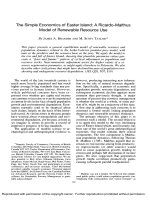A bird eye view of m commerce vương thanh sơn
Bạn đang xem bản rút gọn của tài liệu. Xem và tải ngay bản đầy đủ của tài liệu tại đây (1.97 MB, 37 trang )
A Bird-Eye View of M-Commerce
Prof. Dr. Son Vuong
Director, Networks and Internet computing Laboratory (NICLab)
Computer Science Department
University of British Columbia
Vancouver, BC Canada
Email: or
Hoi Thao ve TMDT, DH Kinh Te Luat
HCMC, 30/11/2012
Prof. Dr. Son Vuong’s Bio Sketch
BSEE Cal State U, Sacto, MEng CarletonU, PhD, U. Waterloo
Lecturer/Assistant Professor, U Waterloo, 1980-82
Joined UBC/CS since 1982
Director of Networks and Internet Computing Lab (NICLab)
(Co)Author over 200 papers, Supervise 80 MSc/PhD theses
Co-edited three books, including “Recent Advances in Distributed
Multimedia Systems” published in 1999
Co-Leader of $30M CAD GISST NCE Proposal (2000)
(Co)chair and (Co)organizer of 10 international conferences
(NCAS’11, Multimedia’08, DMS’08, NOMS’06, DMS'97, ICDCS'95,
PSTV'94, FORTE'89, IWPTS'88).
Consultant for the Canadian Government: Department of
Communications (DOC), Department of Industry (DOI)
Board of Directors for companies, including Confederal Networks
(ConfedNet) and LIVES Mobile Corp.
2
A Bird-Eye View of M-Commerce
Outline
1.
2.
3.
4.
5.
M-Commerce: Introduction
Key Issues/Concerns
LIVES as applied to M-Commerce
Video Clip.
Conclusions
3
Mobile Commerce (M-Commerce)
A form of e-commerce
performed on the internet using wireless
devices such as
4
Handheld computers (tablets), cell phones
(smartphones), dashtop computers (embedded in
automobile dashboards)
Presents unique opportunities and challenges
Popular M-Commerce Uses
Mobile Banking
Mobile stock trading
Mobile ticketing
Digital Wallet
Mobile Coupon
M-Commerce Value
Convenience
Anytime and anywhere access
Personalization and localization
Flexibility
Ubiquity
Who is using it?
USA, Canada
Europe (France, Austria, Germany, Finland,
United Kingdom, etc.)
Asia (Japan, etc.)
Now, worldwide (China, etc. )
M-Commerce Hurdles
Technical Challenge
Security and Privacy
Demography
Usability
Governmental policies and regulations
M-Commerce Hurdles (in the past)
Screens too small and difficult to read
Slow internet speeds
Difficult text entry
Cost of mobile services
The Mega Trends for Internet
Interaction
Connected Group
Reed Law (2n)
?
Level of Interaction
Individual
Metcalfe Law (n2)
Smart
Content
Content
User
0
Information
User Generated
Content
12 Consumer products
8
9 10
710
11
10
Industrial
Vehicular
telemetric
10
10
Residential
Computers
&
commercial buildings
Shipping automation
logistics
50 Years
Time
The End State of Connectivity
Ubiquity and Mobility
Connected Mobility 24/7
3 Billions
200 Millions
(5B
downloads)
The Rise of Mobile Broadband
To enable x10 (speed) x10 (devices) x10 (industries)
Connected Devices
Tablet and Smartphone
Laptop and Cellphone
Anything that can be connected
will be connected
Mobile Broadband Landscape
Cellular Wireless Law of Speed vs. Decade
1T
100G
5G
10G
4G
Gbps
?
Mobile device
for everything
Cell size shrinks
Ce
count increases
3G
50
16
Mbps
2G
kbps
1G
bps
AMPS
4
1
30 Years
1980
1990
2000
2010
2020
Time
E-Commerce Business Model
14
E-Commerce: Business Models Issues
Possible Models:
Slotting fees
Wireless advertising (text)
Pay per application downloaded
Pay per page downloaded
Flat-fees for service & applications
Revenue share on transactions
Trust issues between banks, carriers, and
portals
Lack of content / services
Types of M-Commerce Applications
Methods for delivering M-Commerce services
Directly from cell phone service providers
Via mobile Internet or Web applications
16
Location-based m-commerce applications
Using Short Message Service (SMS) text
messaging or Multimedia Messaging Service
(MMS)
Using short-range wireless technology, such as
RFID
Kinds of business models
Brokerage: market makers bring together
buyer and sellers
Advertising: web advertising providing
advertising messages
Infomediary: collecting and disseminating
information
17
Assessing a business model
Can be assessed by looking at the
marketing strategy
Can also be assessed by technology
- imitation
- complementary assets
Financial measures
Competitor benchmarking
Market analysis
18
Traditional vs. New Business Models
Traditional
New Business
Distribution
Mass
Manufactures push
Middleman
Personalized
Customer Pull
Direct
Communications
Closed
Open
Finance
Slow
Difficult
Local
Mass
Physical
Fast
Easier
Global
Niche
Virtual
Production
Markets
Assets
19
Consumer Decision Process
Consumer Decision Process
Problem - Recognition
PRE-PURCHASE
Information Search
Evaluation of Alternatives
PURCHASE
Purchase Decision
Satisfaction
POST-PURCHASE
Loyalty
Disposal
20
Consumer Decision Process — Flower
Example
Flowers
Problem - Recognition
Pre-Purchase
Need recognition, potentially triggered by a
holiday, anniversary or everyday events
Search for ideas and offerings, including:
– Available on-line and off-line stores
– Gift ideas and recommendations
– Advice on selection style and match
Evaluation of alternatives along a number of
dimensions, such as price, appeal, availability, etc.
Purchase decision
Message selection (medium and content)
Information Search
Evaluation of Alternatives
Purchase
Purchase Decision
Post-sales support
– Order tracking
– Customer service
Education on flowers and decoration
Post sales perks
Satisfaction
PostPurchase
Loyalty
Disposal
21
Metrics
Metrics: If it moves, measure it!
Measures of performance; may be quantitative
or qualitative
Response times
Site availability
Download times
Timeliness
Security and privacy
On-time order
fulfillment
Return policy
Navigability
22
Some Specific M-Commerce Issues
1.
Electronic Payment System (Smartcards)
2.
Marketing/Advertisement and Hospitality
(LIVES)
23
Electronic Payment System
•
proximity payment system
–
•
allows customers to transfer funds wirelessly between their
mobile device and a point-of-sale terminal
Electronic cash (e-cash or digital cash)
–
–
Provides a private and secure method of transferring funds from
a bank account or credit card to online vendors or individuals
PayPal
•
•
E-cash benefits
–
–
•
Privacy - hides account information from vendors
Convenient if seller cannot process a credit card
Smartcards
–
24
Best-known e-cash provider
Credit cards with embedded microchips that can store and
process data and can be used as electronic wallets
Learning Through Mobile Technologies
Prof. Dr. Son Vuong
Networks and Internet Computing Laboratory (NICLab)
Computer Science Department
University of British Columbia
Vancouver, BC CANADA
In parnership with
the Commonwealth of Learning (COL)
25
1









